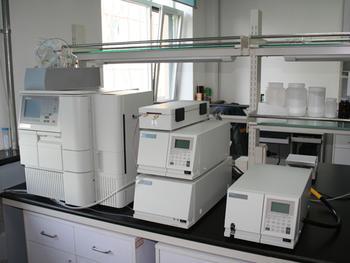Liquid Chromatograph Troubleshooting Methods
 First, the retention time changes
First, the retention time changes There are three changes in retention time: fluctuations, shortening, and prolongation.
When the retention time fluctuates, check whether the column temperature is at a constant temperature. If it is set to room temperature, the temperature change will cause the retention time to fluctuate. It should be set to a constant temperature; when the equilibrium between the isocratic degree and the gradient is not fully reached, it should be Use more than 10 times the column volume of the mobile phase to equilibrate the column; when the buffer concentration is too low, use >25mmol/L buffer; when the column is contaminated or near the column lifetime, replace the guard column or replace the chromatogram column.
When the retention time is shortened, the flow rate increases, and the setting of the flow rate should be checked; when the column temperature is high, the setting of the column should be checked; when the injection volume is too large, the amount of sample or the concentration of the sample is reduced; the composition of the mobile phase is changed, for example, The volatile organic phase in the mobile phase evaporates, and the miscibility between the two phases is not good, which can result in non-uniformity of the mobile phase or partial precipitation of a certain phase; the PH value of the mobile phase should be kept in the range of 3 to 7.5, otherwise it will cause column bonding. Loss of phase.
When the retention time is prolonged, the flow rate is reduced. Check the setting of the flow rate and whether there is leakage in the piping. When the column temperature is low, check the setting of the column temperature; the composition of the mobile phase has changed, such as evaporation of the volatile organic phase in the mobile phase. The poor mutual solubility between the two phases will result in non-uniformity of the mobile phase or partial precipitation of a certain phase; check whether the pH of the mobile phase is in the range of 3 to 7.5, otherwise the column bonding phase will be lost.
Second, peak tail
When the column is overloaded, reduce the injection volume or dilute the sample or use a highly soluble column; if the column performance is poor, replace the column; if the dead volume or the volume outside the column is too large, the connection is minimized and Make reasonable adjustments for all connection points and use as thin ID connections as possible; add silanol, the role of which is to purify the column, increase the buffer concentration, lower the pH of the mobile phase, purify the sample; when peak interference occurs, Clean the sample and adjust the mobile phase.
Third, the peak width
When the injection volume is too large, use the mobile phase matching sample; when the sample is overloaded, enter the small concentration, small volume sample; when the peak expansion is caused in the injection valve, air bubbles are discharged before and after the injection to reduce the diffusion; when the viscosity of the mobile phase is too high Increase the column temperature and use a low-viscosity mobile phase. Equivalent elution, if the retention time is too long, increase the flow rate or use gradient elution; when the volume outside the column is too large, [1] connects the tube diameter and the connecting tube. To a minimum.
Fourth, the baseline noise
When there are bubbles in the mobile phase or detector, the mobile phase should be degassed; when the detector lamp has continuous noise, the xenon lamp should be replaced; when there is random noise caused by contamination, the column should be cleaned, the sample cleaned, and the HIPLC used. Level reagents; occasional noise, may be interference from the power supply, if the voltage is unstable, should be used regulated power supply.
Other Composite Materials Cutting
Other Composite Materials Cutting,Cotton Cloth Cut Machine,Digital Cutting Machine,Composite Material Cutting Machine
Jinan Zhuoxing Intelligent Technology Co., Ltd. , https://www.zxtcuttingsystem.com